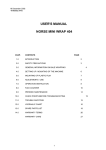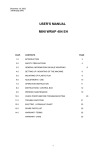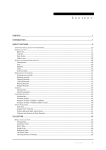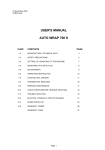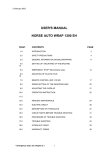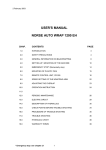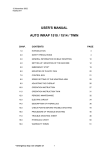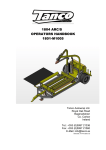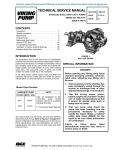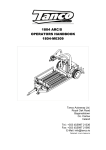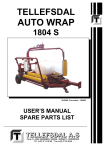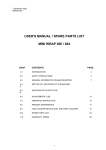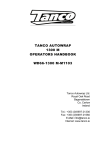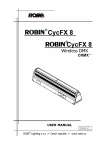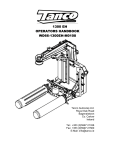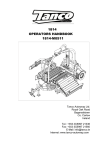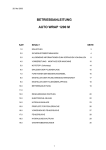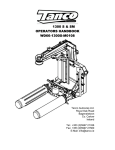Download USER`S MANUAL AUTO WRAP 1300
Transcript
11 November 2002 1300E20.wpd USER'S MANUAL AUTO WRAP 1300 CHAP. CONTENTS PAGE 1.0 INTRODUCTION 3 2.0 SAFETY PRECAUTIONS 4 3.0 GENERAL INFORMATION ON BALEWRAPPING 8 4.0 SETTING UP / MOUNTING OF THE MACHINE 10 5.0 EMERGENCY STOP* (Instant stop) 13 6.0 MOUNTING OF PLASTIC FILM 14 7.0 REMOTE CONTROL UNIT 15 8.0 FLEX COUNTER 19 9.0 SPEED SETTING OF THE WRAPPING ARM 24 10.0 ADJUSTING THE OVERLAP 25 11.0 OPERATION INSTRUCTION 26 12.0 PERIODIC MAINTENANCE 27 13.0 ELECTRIC CIRCUT 28 14.0 DESCRIPTION OF HYDRAULICS 31 15.0 CHECK POINTS BEFORE TROUBLE SHOOTING 34 16.0 PROCEDURE OF TROUBLE SHOOTING 35 17.0 TROUBLE SHOOTING 36 18.0 HYDRAULIC CHART 37 19.0 WARRANTY TERMS WARRANTY CARD 38 39 1 AUTO WRAP 1300 Bale wrapping machine 1. 2. 3. 4. 5. 6. Wrapping arm motor Wrapping arm Prestretcher Rollers Support roller Cutter 7. 8. 9. 10. 11. 2 Main frame Speed control Stationary arm Lifting sling Emergency stop* 1.0 INTRODUCTION. TELLEFSDAL A.S congratulates you with the choice of AUTO WRAP bale wrapping machine. We are certain you will be satisfied with the machine, and that you will have the pleasure of your investment for many years. The AUTO WRAP bale wrapping machine has more features than any other bale wrapping machine available. AUTO WRAP can pick up the bale, wrap and stack them without the operator leaving the tractor cab. This system is protected by patent law's almost world wide. AUTO WRAP 1300 is hydraulically driven by the tractors hydraulic system, and is controlled from the tractor cab by a remote control unit. The machine can either be mounted to three point linkage, front mounted with quick-couplers to the tractors frontloader or on a wheel loader. Then it's possible to stack the bales upon each other. AUTO WRAP 1300 is designed to wrap bales of grass, hey or straw, with nominal diameter of 110-150cm, and weights up to (1200kg). The machine is developed and has been improved since the beginning in 1986, and is now a very reliable and safe machine with high security built in. This manual is meant to explain how AUTO WRAP is prepared, mounted, used and how it works, and shall together with the spare part's list be a reference for maintenance and troubleshooting. So take good care of the books, they are a part of the machine. Read carefully through this manual, and specially chapter 2.0, safety instructions, before starting the machine, and follow the instructions thoroughly. If problems should occur, check with chapter 16.0, and try to find out what is wrong. Ask your dealer for advice before you make the problem worse than it is. See also chapter 18.0, conditions of warranty. * EMERGENCY STOP. Auto wrap 1300 is equipped with a so-called emergency stop on the wrapping arm. This device stops all functions momentarily, but is per definition not an emergency stop, because it does not shut down the inputs. But it has the same function, so we have decided to call it an emergency stop in this manual. Technical Specifications AUTO WRAP 1300 2420 mm 1300mm 2450 mm 590 kg 22 revolutions' per minute 27 revolutions' per minute ø1500 mm 1200 kg Approx. 25 bales per hour 750 mm 1 pcs. single working, + free return 180 bar / 15 litres per minute 40 litres per minute 10 bar 12 V DC Height in working position, min. / max. Width, min. / max. Length, min. / max. Weight Wrapping arm speed, recommended Wrapping arm speed, max. Bale size, max. Bale weight, max. Capacity Prestretcher Hydraulic connection Oil pressure / amount, min. Oil amount, max. Counter pressure, max. Electric connection TELLEFSDAL A.S can change the construction and/or technical specifications without warning and without rights to changes on already delivered products. © Copyright. All rights reserved. Any copying and reproduction of this manual are not permitted without permission from TELLEFSDAL A.S. With precaution of printing failure. 3 2.0 SAFETY PRECAUTIONS. TELLEFSDAL A.S does not take the responsibility for damages that may occur on machine, persons or other equipment, because of the machine NOT being used as described in this manual, or because of the safety precautions NOT being followed. 2.1 SAFETY EQUIPMENT. Before using the machine, make sure that all guards and covers are securely fitted. The machine must not be operated if a function does not work as described later in this manual. (See chapter 2.5). 2.2 BECOME FAMILIAR WITH THE OPERATIONS OF THE MACHINE. If you are unsure how to operate the machine properly, either use of or maintenance to your Auto Wrap, please contact your Auto Wrap dealer. 2.3 ADJUSTMENTS' / MAINTENANCE. Turn off the tractor and discharge the oil pressure before performing any adjustment or maintenance on the machine. Remember that a well maintained machine is a safe machine. 2.4 IMPORTANT! MAKE ALWAYS SURE THAT NOBODY IS IN THE HAZARD AREA OF THE WRAPPING ARM WHEN THE MACHINE IS IN USE. THE MACHINE MUST NEVER BE OPERATED BY PERSONS WHOM DOES NOT KNOW ENOUGH ABOUT HOW TO SAFELY OPERATE THE MACHINE, OR BY PERSONS UNDER 16 YEARS OF AGE. 4 Fig. 2-2 2.5 Fig.2-3 DANGEROUS AREAS. TELLEFSDAL A.S has given the safety to the operator the highest priority, but it is still impossible to secure oneself of every danger area on the machine. Therefore we will now go through some of the dangers that can occur when using the Auto Wrap balewrapper. 1. PUNCH OF THE WRAPPING ARM. During the wrapping process the arm rotates with a speed of 20-27 revolutions per minute around the bale. On the arm there is mounted a prestretcher unit with a plastic roll. The speed on this can give a person serious injuries if one comes to close to the working area of the wrapping arm. To reduce this danger we have mounted an emergency stop* device on the wrapping arm, this stops all movement instantly when someone comes in the way of it. It is very important that this protection always works and that it should not under any circumstances be disconnected. (See more about the emergency stop* in chapter 5.0). 2. SQUEEZE-DANGER BETWEEN THE MAIN FRAME AND THE WRAPPING ARM. As earlier explained, we have a wrapping arm with a prestretcher and a plastic roll. Once every time around this wrapping arm passes the main frame. Here there may occur a squeeze danger if a person stands to close to the main frame when the wrapping arm passes. The distance between the main frame and the wrapping arm is not large enough to give place for a person. Between the prestretcher and the bottom frame there can also be a squeeze danger. 3. SQUEEZE-DANGER BETWEEN THE STATIONARY AND THE WRAPPING ARM. During the main wrapping process the wrapping arm moves around a stationary arm. Every time the wrapping arm passes the stationary arm, there is a squeeze danger that can be dangerous for the fingers. The distance between the stationary and the wrapping arm is between 25-40 mm. (See fig. 2-2). 5 4. SQUEEZE DANGER BETWEEN THE ROLLERS AND THE MAIN FRAME. During the wrapping process the bale rotates on two rollers. When the rollers are in motion there is a danger of being squeezed. 5. SQUEEZE DANGER BETWEEN TELESCOPE FRAME AND MAIN FRAME, INWARDS. When loading a new bale, the telescope frame moves towards the main frame, be aware of the danger. 6. SQUEEZE DANGER BETWEEN TELESCOPE FRAME AND MAIN FRAME, OUTWARDS. On both ends of the telescope frame there can occur a squeeze danger when loading a new bale. Keep there fore hands and feet away from this area. 7. SQUEEZE DANGER CAUSED BY PLASTIC AUTOMATION. At the end of the wrapping process the plastic shall be perforated and held tight until the start of the next wrapping process. When the cutter arm moves down to lock the plastic, there can occur a squeeze danger between the cutter arm and the cutter holder. The cutter blade that perforates the plastic is very sharp, so keep hands away from the cutter. (See fig. 2-3). 6 2.6 LOCKING THE WRAPPING ARM. When the machine is not in use, make sure the locking bolt for the wrapping arm is mounted, and that the secure pin is fitted. If the bolt is not mounted, the wrapping arm and/or the machine could be damaged during transport. 2.7 THREE POINT MOUNTING. When the machine is mounted in the three point linkage, make sure that the lifting arms are tightend up so there is no sideways movement. 2.8 FRONT MOUNTING. If the machine is mounted on the front loader there must be a counterweight in the three point linkage. It must be large enough to give the tractor good stability. Connecting heavy working implements often has an overall negative effect on the tractor's driving and braking capacity. ! 2.9 TRANSPORTING. When transported on a public road there are certain safety measures that must be taken: 1. Make sure that the locking bolt on the wrapping arm is mounted. (Chapter 2.6). 2. Move the main rollers completly together. 3. Always transport the machine in the lowest possible position. 4. Make sure that the machine do not cover the tractors lights. If necessary, mount extra lights. 5. Make sure that at least 20% of the tractor's total weight is on the steering wheels. 6. If the machine is front-mounted, it's necessary to balance the weight with a counterweight mounted to the three-point linkage. 7 3.0 GENERAL INFORMATION ON BALE WRAPPING. 3.1 THE PRINCIPLE. The advantages of round bale ensilage are many, and include fewer feed units, a flexible harvesting system, large capacity and the possibility of selling feed units. In principle, the same fermentation processes occur whether the fodder is placed in a silo or pressed into bales and packed in plastic, i.e. lactic acid fermentation in anaerobic conditions. The oxygen in the bale must be exhausted before fermentation begins. The grass should be dried to approximately 30-40% solid content. The solid content can be determined by twisting the grass by hand. If drops of liquid are forced out of the grass, the solid content is less than 25%. Low solid content, (wet grass), can lead to increased butyric acid fermentation if preservatives are not added to the grass. If the solid content is too high, (over 50%), normal fermentation will not take place and there will be enough oxygen in the bale to produce mould fungus. 3.2 THE BALER. It is vital that the baler produces compact, well-formed bales, as misshapen bales can be difficult to wrap. Pressing will also often take longer, thereby increasing the amount of plastic used. 3.3 DIFFICULT BALES. When a misshapen bale is wrapped, it will have a tendency to move outwards or inwards on the roller. If the bale begins to move outwards, the machine must be lifted slightly at the rear edge to get the bale to rest against the support roller on the main frame. It can therefore be useful to use a hydraulic top link to make this adjustment easier. (See chapter 4.2). If the support roller almost disappear into the bale the machine should be pressed down slightly at the rear edge in order to remove the bale from the machine. The plastic can be damaged when friction against the roller increases. Best results are achieved when the bale rolls easily against the support roller all the time. If the bale to be wrapped is conical you must ensure that the sharp end is pointed at the tractor. It will then be easier to get the bale to lie correctly during packing. It is easy for such a bale to "turn" forward in the direction in which it is pointing, and therefore lie against the support rollers. If the bale is lying on a slope it must be picked up from the lower side. A hydraulic top link will again be advantageous. 3.4 TYPES OF PLASTIC. A good type of plastic with good adhesive properties, and which is recommended for bale wrapping, must be used. The thickness of the plastic foil should be at least 25 µ. (25/1,000 mm). In order that the plastic tightens sufficiently around the bale, it is stretched before being wrapped, so it is somewhat thinner when it is put on the bale. With short-term storage, (up to eight weeks), it is recommended that bales have a minimum of four layers of plastic at the thinnest points, with at least 52-53% overlap. For long-term storage, or when the grass is wet when it is wrapped, the bale should have 90-100 µ plastic, (6 layers), and the same amount of overlap. If thinner plastic is used, more layers should be applied. If it is very hot the plastic will be stretched further, and more layers should be applied. It is better to have slightly too much than too little plastic on the bale. From experience, light plastic produces slightly lower temperatures within the bale, and tends to improve feed quality. 8 3.5 STORAGE LOCATION. Care should be taken in finding a suitable location for the storage of bales. The storage location should preferably be prepared before the bales are laid out. An elevation close to well-drained roads is recommended. If the wrapped bales are simply placed on stubble there is a danger of the plastic being pierced. A tarpaulin or a thin layer of sand should therefore be laid where the bales are to be stored over the winter. Bales should be stored in the shade as far as possible. This reduces the danger of air leakage in the bales. A bale which is stored in sunlight and which therefore undergoes greater swings in temperature "pumps in" a great deal of air in comparison to a bale which is stored in the shade. According to "Teknik for Lantbruket" [Technology for Agriculture] in Sweden, a bale which is stored in the shade has only 40% of the air leakage of a bale which is stored in sunlight. 3.6 STACKING / PROTECTION. If bales are hard and well formed, they can be stacked vertically, but loose and misshapen bales with low solid content should not be stacked higher than one layer, as this could easily cause deformity and the danger of runoff will be increased. Bales can also be stored on their sides. The layer of plastic is thicker here, providing greater protection against piercing. Bales should be covered with a tarpaulin or a fine-mesh net to protect against birds and small rodents. If the plastic is pierced, it must be sealed with weatherproof, hard-wearing tape, preferably under the outermost layer of plastic. Ensure that the hole is adequately sealed. 3.7 The best wrapping results are obtained by... i ...harvesting the grass early. i ...drying it out to 30-40% solid content. If there is a danger of rain, bale and wrap the grass anyway. i ...taking care not to mix any earth in with the grass. i ...using a baler that produces even, firm bales. Bales 1.2 m in width and with a diameter of 1.2-1.5 m are the preferred sizes. i ...wrapping the bales soon after baling, never later than two hours afterwards. i ...using a good plastic type and six layers of plastic. This removes the need to use preservatives. i ...storing bales in the shade to reduce the danger of air leakage. 9 Fig. 4-1 4.0 SETTING UP / MOUNTING OF THE MACHINE. Be careful! There is a danger of being crushed when working implements are fitted and connected. Carry out the fitting procedures slowly and carefully, and use separate and approved lifting equipment to make the work easier. See section 2 on safety regulations and pay attention to the various safety decals displayed on different parts of the bale wrapper. ! 4.1 THREE POINT LINKAGE. AUTO WRAP 1300 is intended for rear mounting to the three point linkage, category 2. With considering of transportation are not the three point brackets mounted on the machine when it leaves the factory. When attached to three point linkage, make sure the machine is level across the tractor. Tight up and lock the lifting arms so there is no sideways movement. 4.2 TOP LINK. Adjust the top link of the tractor so that the machine is level with the ground. It is recommended to use a hydraulic top link, as this makes it easy to adjust the angle of the machine. During the wrapping process it is recommended to tilt the machine towards the tractor, as this will prevent the bale from falling off the rollers. (See fig. 4-1). 4.3 FRONT MOUNTING. As extra equipment the machine can be equipped with quick-couplers for front loader or wheel loader. (See spare parts list chapter 2-2 for what types of quick couplers there are). You also need longer hydraulic hoses. (See spare parts list chapter 4-2 for more details). When front-mounted there must be mounted a large enough counterweight in the three point linkage, this is to secure the tractors stability. 10 Fig. 4-7 Fig. 4-5 Control box 1300 M 4.4 Fig. 4-6 Control box 1300 EH ELECTRIC CONNECTION. The electric supply for the machine's remote control and electro-hydraulic components must come directly from the tractors' 12 volt battery. The electric wires from the battery must have an area measurement of min. 2,5 mm2. Connection to other contacts on the tractor can cause risk of misfunctions, and is not to recommend. BROWN LEADER GOES TO BATTERY PLUS POLE BLUE LEADER GOES TO BATTERY MINUS POLE 4.5 REMOTE CONTROL BOX 1300 M. The control unit, which consists of a joy-stick, to way switch and the emergence stop button, should be attached to a suitable place in the tractor cab, next to the front loader's operating lever if the machine is front mounted. 4.6 REMOTE CONTROL BOX 1300 EH. The control unit consists of the emergence stop button, a steering cable, a fuse and a battery cable. The control unit should be attached to a suitable place in the tractor cab. THE REMOTE CONTROL UNIT IS NOT SHOCK-PROOF. MAKE SURE THAT IT IS FASTENED TO A SOFT PAD THAT SECURES A NON-VIBRATING FOUNDATION. 4.6 HYDRAULIC CONNECTION. The hydraulic hoses between machine and tractor are equipped with 1/2" ISO male quick-couplers. Discharge the oil pressure before you connect the oil hoses. Use the tractors' hydraulic lever. To make sure that the balewrapper works properly, the tractors' oil pressure has to be at least 180 bar. The oil flow should be 15 - 25 litres per minute. The counter pressure on the return must be as low as possible, and not exceed 10 bar. This should be measured with a gauge. It is recommended to use one single-working hydraulic outlet and arrange a free return circuit to the oil tank. If you are unsure of what oil pressure the tractor gives, or what oil pressure the balewrapper receives, please contact your machinery dealer. Generally all tractors have got some counter-pressure in their hydraulic return systems. Some tractors have more than others. Hose with red cap shall be connected to pressure, (P), and hose with blue cap to the return. (T). 11 4.8 OPEN AND CLOSED CENTRE HYDRAULIC SYSTEM. With the ball valve you can choose between a hydraulic system with open or closed centre. Almost all tractors have a hydraulic pump that gives a fixed oil flow per revolution. (Open centre). AUTO WRAP 1300 is sat in the open position on leaving the factory. Some tractors, (like f.i. John Deere), have an oil pump with variable volume per revolution. (Closed centre). The contents of V6 must be replaced with pos. 13 and V7 with pos. 15 in the spare parts list. 4.9 CHECK LIST. Before using the machine it is recommended to follow this check list: 1. Make it a habit to discharge the oil-pressure before connection or disconnection of the hydraulic hoses. (By operating the hydraulic control lever inside the tractor). (Use the tractors hydraulic control lever). 2. Return-oil should be led as directly to tank as possible. Beware that if the counter pressure is too high, the security valve on the main block will release some oil. (See chapter 13). 3. Hose with BLUE CAP = RETURN OIL. 4. Hose with RED CAP = PRESSURE. 5. Tie up loose hoses so that no squeeze damages occur. 6. Remove the locking bolt that holds the wrapping arm to the frame during transport. 7. Start the tractor and try out the functions. A bale is not required for this test. 8. Check all connections, hoses and couplings. If there is any oil-leakage, it should be rectified immediately. If any problems should occur, it is most likely that the failure is in the quick-couplers on the tractors pressure and return-connections. Make sure that both the male and the female-couplers opens properly for the oil flow. Check them carefully. The best thing to do is to exchange the quick-coupling on the return side and arrange a "free return". Your AUTO WRAP bale wrapper has been tested in practical operation in approx. 2 hours at the factory. 12 5.0 EMERGENCY STOP*. 5.1 The machine is equipped with a safety guard on the wrapping arm, and its operation must be tested before work itself is started. 5.2 The emergency stop* is to prevent the wrapping arm from damaging people and objects, when the machine is started and during the packing proses. 5.3 It consists of a releaser hoop that activates a small electric switch, which gives a signal to the control box to start the emergency stop. 5.4 When this function shall be tested, you start the wrapping arm. Hold out an arm or any obstacle. The wrapping arm shall now stop before it hits the arm. 5.5 To restart the machine the obstacle must be removed and the arm must be returned to its original position. The switch on the control box (1300 EM) must be turned back to the zero position. The wrapping may start again. 13 Fig. 6-1 Fig. 6-2 6.0 MOUNTING OF PLASTIC FILM. 6.1 When the plastic roll shall be mounted, you have to hold the prestretcher-rollers aside, Hold the rollers aside and put on the holding hook. (See fig. 6-1). 6.2 Place a reel of film on to the prestretcher's holding axle and put on the springloaded lock. On delivery the prestretcher is set for the 750mm film, the top bracket may be moved down enabling the use of the 500mm film. (See fig. 6-3). 6.3 Pull the film between the rollers on the prestretcher in the direction of the arrow. (See fig. 6-2). (See also the sign on the wrapping arm). 6.4 The filmholder / cutter is opened, pull out the film and place it over the U-shaped slot. 6.5 The cutter is closed, and the film will be held in place. 6.6 Height adjustment of prestretcher / plastic film. The plastic film shall hit at the middle of the bale wrapped, and therefore it can be necessary to adjust the height of the prestretcher. (See fig. 6-4). Fig. 6-3 Fig. 6-4 14 7.0 CONTROL BOX FUNCTIONS. 7.1 1300 EM CONTROL BOX FUNCTIONS. 7.1-1 JOYSTICK : Up = CUTTER OPEN Left = ROLLER OUT Right = ROLLER INN Down = CUTTER CLOSED 7.1-2 TWO STEP SWITCH The Two step switch steers the wrapping arm. The first step reduces the speed on the wrapping arm by half, to enable a smoother start and stop to the wrapping proses. 7.1-3 EMERGENCY STOP The emergency stop arm stops the wrapping sequence instantly, and cuts out all the power supply to the machine. The emergency stop is cancelled by turning the switch to the right. 7.2 1300 EM CONTROL BOX FUNCTIONS. 7.2-1 FUNCTIONS Arm- model 15 7.2-2 PROGRAMMING Arm- model Auto-wrap Controlbox 2000 16 mars 2000 JH 2. Programing Notice: By pressing "EXIT" more than 3 sek.you allways will be braught back to "Wrap-cycle" ( Wrapp modus) By pressing "MENU" more than 3 sek, the display contrast will be adjusted. "MENY" up = Stronger MENY down = weaker Manual operation Behind the rubberplug on the the rear side of the control box it is placed a switch for manual/automatic operation. Please notice that the display does`nt work in manuel modus. Display nbr ( ) Wrap cycle: 0-10 Balecounter 1: Programing nbr laps/bale MENU Adjust flashing numbers SET: Change SET: next EXIT: Store EXIT: Store EXIT: Store 2 Setup MENU Reset Modell 3 SET: Change 1514 TWIN 1510 TWIN 1514 1510 1300 MENU Find the right model 5 6 7 8 9 10 11 12 13 14 15 16 17 Actual RPM: (Alarm limits :23-27) Press SET to change settings Stop bale rotation first filmlayers Stop bale rotation numbers of layers Rotate slow start duration Film layers until release film Rev.puls to cutter open delay Release film (open) duration Rotate fast ,start of final rev. Pass sensor duration, (before film cut) Cut film (close) duration Reverse duration, after film cut. (Twin) Manuall rollers - in hold duration Manuall rollers - out hold duration Manual rotate bale hold duration EXIT: Store EXIT Store MENU 1300 * * 3.0 2.0 0.5 0.4 1.0 1.0 2.0 * 0.0 0.0 0.0 1510 1514 1510T 1514T * * 3.0 2.0 0.5 0.4 1.0 1.0 2.0 * 0.0 0.0 0.0 No 4.0 3.0 2.0 0.5 0.4 1.0 1.0 2.0 * 0.0 0.0 0.0 No 4.0 3.0 2.0 0.0 0.3 0.4 0.9 2.0 1.5 0.0 0.0 0.0 No 4.0 3.0 2.0 0.0 0.3 0.4 0.9 2.0 1.5 0.0 0.0 0.0 MENU : Adjust flashing numbers EXIT: Store Actual wrapping speed Alarm on 23 rpm Stop 27 rpm Home (2 ) 20 Balecounter 21 SET: Change 16 22 22 23 24 25 Reset possible ? Yes Bales total for all 9 balecounters Bales machine total Balecounter 1: 2: 3: Balecounter 4: 5: 6: Balecounter 7: 8: 9: Working HRS: Machine tot: No Yes Yes Yes SET: Change MENU: Reset EXIT: Store Reset possible ? Yes No SET: Change MENU Reset EXIT: Store SET: Change 26 Language : Audioalarm & Display 27 28 SET: Change Dänish English Nederlands Francais Deutsch EXIT: Store MENU: Adjust flashing numbers EXIT: Store SET: Change 29 Audio alarm 30 Display contrast 31 Display light HardwareTest MENU: Adjust flashing numbers On 100 On SET: Enter 32 Description 33 Supply voltage Last drop to 34 Test keys pressed 000.000 35 Test switches aktivated 00.00.00.00.00 36 Relays, 0=off.AMP nbr 0--.0000.000-.-00 37 Counter input 38 39 Home (2 ) 26 Working hours since last reset 26 Working hours machine total Nr 2: Emergencystop input Nr 3: Infra Red reciever input Test Infra Red remotecontrol 00.00.00.00 Present voltage Last registrated drop of voltage. (Test 6 programbuttons) (Test av 5 stk funktion switches) ( Test relayoutputs. AMP sprocket 1-14 ) Notice ! nbr 10,11,12.13,14 are indicated with A,B,C,D,E Inputsignal from counterswitch 1=Yes O= No Inputsignal from Em.stop switch Is the IR reciever connected. Inputsignal from IR sender 17 1=Yes O= No 1=Yes O= No 1=Yes O= No EXIT: Store SET: A signal change the displayed out/in put from 0 into 1. 7.2-3 WORK CYCL Arm- model 12,00 12,00 Programpages H 21,00 J I G E F LT 2000 Start A B C 15,00 D D CR- 900 3-7 B 0:15 (7) 0:26 0:14 ( 8) (9)(10) 0:16 ( 11 ) Start 1/2 speed 1/1 speedsignsl to valve nbr6 1 lap displayed 2 laps displayed Release film from cutter. Wrapping Runs further into nbr of progr. revolution per/bale (-2) E Display adds 1 per laps. D C Stop A F Stopsequence starts. G Time duration until cutter is Start/stop opening. 18,00 H The cutter is opening completly wrapp.arm slows down. (1/2 ) 0:17 I J Duration from "I" to stop. 0:18 0.19 Cunterswitch Traktor 18 Wrapp.arm stops and cutter close and hold the film. ( 12 ) ( 13 ) 3.Wrapping cycle Rotation 8.0 Flex Counter revolution counter and wrap counter 8.1 Introduction The flex counter is an instrument with many functions. The unit consists of a box with a display and two control keys. Both the display and the control keys are large and easy to use. The flex counter has six functions,. Which function one choses to use, is selected by depressing the keys on the control box as with the revolutions and bales count (F.6). The flex counter will hear after be referred to as the computer. 8.2 Programming the Flex Counter. Right below, the programming rules of the Flex Counter are described. Furthermore, the chapter “ The individual functions” gives a more thorough description of the 6 functions and their attached input and output factors. 8.3 Changing the functions of the Flex Counter. Changing from one function to another is done in the following manner: Key Display Example : Changing function. Explanation F. 1 The current function is found on the display. F. 1 Press the key for app. 2 sec - the function number starts flashing, indicating that its value may be changed. F. 6 Push repeatedly until the function number is correct. F. 6 Press the key for app. 2 sec - the change is completed. Furthermore, programming-mode is automatically exited, if the Flex Counter does not receive signals from the keys within a 10 second interval. 19 8.4 Changing and resetting values. As previously mentioned in the introduction, the computer has six functions. The table below shows these functions. The relationship between functions and input-/output factors. No. Function Factors Speed indicator Reset or Change Speed Display symbol _._._._ Wheel circumferen. Area I Area II Wheel circumferen. Working width Units Counting factor Rev. pr. minute RPM-hours Working hours Wrap counter Wrap number Bales I Bales II o HA. 1 HA. 2 o |----| cou. cou.F r. --:---:-PULLS PULLS bale.1 bale.2 C R R C C R C Limits 0,0 - 999,9 km/t F. 1 F. 2 Area counter F. 3 Unit counter F. 4 Revolution counter F. 5 F. 6 Working hours Wrap counter R R R C R R 00,00 - 999,9 cm 0,000 - 9999 ha 0,000 - 9999 ha 00,01 - 999,9 cm 00,01 - 99,99 m 0,001 - 9999 pcs. 0,001 - 9,999 pcs. 0012 - 9999 rpm 00:00 - 9999 hours 00:00 - 9999 hours 0 - 99 rev. 2 - 99 rev. 0 - 9999 bales 0 - 9999 bales The table shows, which values may be changed and which may only be reset. Values that may be changed are indicated by a C. Values that may only be reset are indicated by an R. If values are to be changed, the function containing the specific value must first be entered. Please refer to the table above. 8.5 Example on setting the number of rotations per bale. Remember to set the computer on the correct function (F.6.) Cross ref.with 8.3 Key Example: changing the revolution per bale from 12 til 31. Display Explanation Press until Pulls is shown on the display. The display shows after a short time the number 0:12 of revolutions the computer is set too 12 The key is pressed for app. 2 sec. The number - 1- will flash in the display and the value may be changed. 32 Press Several times until the value of the first digit is correct. 32 The second digit flashes indicating that its value may be changed. 31 .Press Several times until the value of the second digit is correct. 0:31 The key is pressed for app. 2 sec. programming is complete. Further more, programming-mode is automatically exited, if the Flex Counter does not receive signals from the keys within a 10 second interval. 20 8.6 Example on Resetting the number of bales. Remember to set the computer on the correct function (F.6.) Key Display 120 Example on resetting the number of bales Explanation Press the key until bale.1 is displayed. The display shows after a short period the number of bales which are wrapped. _120 Press the key for app. 2 sec. - the display starts flashing, indicating that its value may be reset. ___0 Press ones, the display shows a line and a zero. 0 Press the key for app. 2 sec., leaving programming. Further more, programming-mode is automatically exited, if the Flex Counter does not receive signals from the keys within a 10 second interval. The same procedure is used for both bale counters, except for that in the first row the key must be pressed until bale.2 is displayed. The rest of the operation is identical. 8.7 Describing the function “Wrap counter” The wrap counter has three functions. 1. Revolution counter This is a function that monitors the number of rotations the table has taken at any given time. With the help of a sensor and a magnet. The required number of rotations desired per bale may be pre-programed. 2. Bale counter no. 1. This is a function which e.g. counts the number of bales per job or per day. 3. Bale counter no. 2. This is a function which e.g. counts the total number of bales for a season. Bale counters 1 and 2 may be used when and where it is appropriate. The wrap counter is equipped with one alarm. The alarm is activated: * One rotation before the pre-set required number of rotations is reached. When the next pulse signal is received the alarm stops, but is activated again, if one or more pulses are received. The values of the bale counters are increased by one when: * The pre-set required number of rotations is reached. The revolution counter (wrap counter) is reset: * When the required number of rotations has been reached, and the computer does not receive any more pulse signals within a 10 seconds period. * The -key is pressed while the display shows the wrap number (PULLS function). NOTE! If there are to many rotations on one bale, the set-key must be pressed to reset the revolution count. 21 8.8 Turning the Flex Counter on and off-stop-mode. In order to lower the power consumption of the Flex Counter, and there by increasing the life time of the batteries, the computer may be sat in stop-mode. The display will then be turned off and the computer is paused until a new signal is received from the sensor or a pressed key. The computer may be sat in stop-mode manually. This is done by pressing the -key for app. 5 seconds. The display shows “stop” until key is realised, now the display is turned off. If the computer, within 30-90 min. has not received any pulse or key-press signals, the computer is automatically sat in stop-mode. 8.9 Power supply. Low : LB The computer must be supplied with power from two 1,5V AA-batteries. When the computer is re-started having been in stop-mode, the display first shows the version number of the specific computer. The computer then checks the power level, if this is low the display shows -bL-. if the display fades out, the batteries must be changed. If during use, the power supply from the batteries dwindles the computer will occasionally flash the -bL- message. The batteries must then be changed, as counting errors may occur. If display-problems occur after battery replacement, wait for two minutes and then reinstall the batteries. If there is still a problem check that the batteries have a power level of minimum 3V. 8.10 NOTE ! Storing data - the memory of the Flex Counter. The computer is supplied with a memory facility, that remembers the values of the input and output factors. The values of the input factors are automatically stored when they are changed. The value of the output factors are stored once every hour and when the computer is automatically or manually sat in stop-mode. When changing the batteries, the computer must first be manually sat in stop-mode (please refer to the Turning the Flex Counter on and off-stop-mode) Then the batteries may be changed without the risk of loosing data. 8.11 Specification of limits. Pulse signals from the sensor: max. 167 pulse signals per second. min. pulse time: 0,6ms~the magnet must activate the sensor for 1/10 of the time at 9999 rpm. Temperature limits: The Flex Counter is fully operational within -10 to 70 °C. This does not necessarily apply for the batteries, please check with your local battery dealer. 22 8.11 INSTALLING THE SENSOR AND MAGNET The magnet must be mounted on the rotating element, e. g. the table of the wrapper. The sensor must be installed on a bracket, securing that the magnet passes the sensor end within a distance of 2 - 8 mm. See the drawing below: Please notice: If the sensor is to be mounted on a mounting bracket which is magnetizable (iron), then the sensor must be placed at least 5 mm beyond the edge of the mounting bracket. Please take notice, so that the cable from the sensor will be protected and not break when the tractor is turning, or when the hydraulics are used. 23 9.0 SPEED-SETTING OF THE WRAPPING ARM. 9.1 Start the tractor and let it run at approx. 1000 revolutions per minute. Lift the machine clear of the ground.The oil flow to the machine is adjusted by two wheeles which are situated at the top of the mashines valve block. (See A-B Fig. 14-1) 9.2 The Wheel (See B Fig. 14-1) too the right is used to adjust speed of the wrapping arm. 9.3 Adjust the wrapping arm speed to approx. 22 revolutions per minute. (Just below three seconds per revolution.) The adjustment is carried out by turning the wheel on the control valve. Turning clockwise REDUCES the speed and turning counterclockwise INCREASES the speed. It is recommended not to wrap with higher speed than 22 revolutions per minute, because then the plastic film will "catch" more air, and this air do not reach to evacuate from the bale. The result is bad fodder. OBS! Max. allowed wrapping arm speed is 27 revolutions per minute. REMEMBER! Increased speed of tractor engine do not increase the wrapping speed, it only increases the oil flow into the system and by that also the temperature in the hydraulic system. 24 Fig. 9-2 10.0 ADJUSTING THE OVERLAP. 10.1 WRAPPING ARM SPEED. Load a bale on to the machine. To be able to adjust correct overlap, you have to leave the tractor cab while wrapping. Check that the wrapping arm has a speed of approx. 22 revolutions per minute. If not, adjust this by turning the control valve for wrapping arm speed. (See chapter 8.3). When the wrapping arm speed is OK, you can set the overlap. 10.2 OVERLAPPING. Use a black marker to mark a line on the middle of the film wrapped on the bale. Adjust the control wheel (See A Fig. 14-1) for roller speed, so that the marker line is just covered. Approx. 52-53% is the ideal overlap. (See fig. 9-2). This adjustment can be kept as long as you wrap bales with approx. same diameter. When changing bale size, control the overlap. 25 11.0 OPERATION INSTRUCTION. We shall now go through a complete wrapping process, from loading to storage place, and explain the practical use of Auto Wrap 1300. 11.1 LOADING. Pick a bale to wrap. Increase the opening between the rollers as much as possible. Lower the machine almost to the ground. Do not lower the machine all the way down to the ground. Drive in under the bale. Close the rollers until they begin to lift the bale. Lift the machine and the bale approx. 10-15 cm, above the ground. Close the rollers completely. The rollers must not under any circumstances hit the ground while closing. The reason why the rollers shall not hit the ground is that this will increase the wearing on the gears and the bearings of the rollers. 11.2 HEIGHT ADJUSTMENT OF TOWER / PRESTRETCHER. The prestretcher has to be adjusted so that the plastic film is always hitting the middle of the bale. 11.3 START. Remember that the plastic film end has to be locked in the U-shaped slot before starting the wrapping. When the plastic film end is in the slot, use the switch to start the wrapping arm. When the wrapping arm has done a couple of revolutions, lift the cutter-arm just enough to releases the film end. If the cutter is raised to high it may damage the plastic film. 11.4 OVERLAP. Control that the overlap is correct. If not, see chapter 10. 11.5 HOW MANY LAYERS OF PLASTIC FILM? When the bale is completely covered with film, read the counter that displays the number of revolutions done by the wrapping arm. This number has to be multiplied by 2 or 3, depending on how many layers of film you want to have. * 4 layers - multiply by 2. * 6 layers - multiply by 3. As long as you wrap bales with the same diameter, you can stop at the same number every time. 11.6 STOP. One round befor the required number of revolutions is obtained, the speed on the wraping arm is redused, the wrapping arm is stoped when the plastic film is against the cutter. The wrapingarm is knaw in the right position for the next wraping cycle. The cutter closes and the film is held tight in the U-formed slot and perforated. The bale is now completely wrapped and ready for stacking. 11.7 STORAGE PLACE. At the storage place the bales should be placed systematically. Start at the right-hand side, and stack to the left. The machine is lowered, but not all the way down to the ground. The rollers must not hit the ground. Push the lever control for "rollers out" and the bale will rest on the ground. Drive the tractor carefully away from the bale. Try to avoid touching the bale with the rollers. The plastic film will now tear off by the perforation at the cutter. Place the next bale to the left of the first one so that the loose film end on the last ball will be locked. Then you do not have to leave the tractor cab to fasten the loose film end. To be sure we recommend that you check that the film ends are securely fastened, and eventually fasten them a little bit better when you have stacked the bales. If the machine is front mounted, the bales can be staked upon each other. (See more in chapter 3.0). 26 12.0 PERIODIC MAINTENANCE. 12.1 BEARINGS. All ball-bearings are packed with grease, and do not need any more maintenance. 12.2 PRESTRETCHER. If the machine is in daily use, the guiding sleeves at the prestretcher should be oiled once a week or when needed. Sprockets and bearings on the prestretcher should also be oiled when needed. 12.3 CUTTER / FILM HOLDER. The cutter / film holder is preadjusted from the factory and does not need further adjustments. By replacement of some spares it is necessary to adjust it. The springs for the U-shaped slot shall be adjusted so that they are almost completely squeezed together when the cutter-arm is all down. 12.4 CLEANING. The machine should be cleaned and oiled regularly and by the end of the wrapping season. NOTE ! When using high pressure washing apparatus, care must be taken with the electrical installation. Also make sure that water is not sprayed directly into the bearings, etc.. Keep the control box protected from rain and water. If necessary use compressed air to dry electrical components. 12.5 HYDRAULIC CYLINDERS. Make sure that all hydraulic cylinders are closed when storing the machine. 12.6 QUICK COUPLERS. Be painstaking by keeping the quick couplers clean and apply the dust caps after use. 12.7 STORAGE. The machine should be parked on a dry place during the closed season. 12.8 OIL FILTER. The oil filter must be changed once a year. 27 13.0 ELECTRIC CIRCUT. The electric system consists of a remote control box with supply line, control cable, connection box, hydraulic valves, counter and emergency switch. 13.1 CIRCUIT DIAGRAM CONNECTION BOX 1300 EM/EH. 28 13.2 CIRCUIT DIAGRAM 1300 EM. 29 13.3 CIRCUIT DIAGRAM 1300 EH. 30 There are 3 basics which must ALWAYS be followed if the machine is to function correctly 31 Fig. 13-1 14.0 DESCRIPTION OF HYDRAULICS. AUTO WRAP 1300 is driven from the hydraulic system of the tractor. The hydraulics of the machine can easily be changed from "Open Centre" to "Closed Centre" hydraulic system. 14.1 "OPEN CENTRE" HYDRAULIC. Most tractors have an oil pump which gives a certain quantity per revolution. Then the crane handle, has to be set in open position. If no other function is activated, the oil flows from the tractor, through the main valve block and back to the tank. When one of the functions on the control unit is operated, THE MASTER VALVE, closes the oil flow circuit, and simultaneously the valve for the current function is opening. "CLOSED CENTRE" HYDRAULIC. For tractors with a variable oil pump, like John Deere,(See fig 4-7).. The oil can only come into the main valve block when one of the functions is operated. The "closed centre" valve, opens the oil flow into the block, and simultaneously the valve for the current function is opening. THE MASTER VALVE, will always close, and the "closed centre" valve, is automatically opening regardless of which function that is operated. 14.2 THE CUTTER. To prevent that the oil pressure to the cutter is falling, so that it not holds the film long enough, there is a piloted non-return valve, underneath the magnet valve on the main block. Underneath the above piloted non-return valve, inside the block, there is also a non-return valve that prevents that sudden pressure impulses in the return system can open the piloted non-return valve. 14.3 The hydraulic system is equipped with a safety valve, which is preset to 185 bar. It opens for the oil circuit to tank if max. pressure is exceeded. This valve is attached to the main valve block. 32 Fig. 13-2 Fig. 13-3 NUMERICAL ORDER OF THE MAGNET VALVES The numbers of the magnet valves are identical with the corresponding numbers on the electric leaders. Valve for CUTTER = Valve no. 1 - 2 Valve for ROLLERS IN / OUT = Valve no. 3 - 4 Valve for wrapping arm, ½ speed = Valve no. 5 Valve for wrapping arm, full speed = Valve no. 6 Master valve = Valve no. 7 OTHER VALVS "Closed / Open centre" plug Safety limit valve Power limit valve for wrapping arm Stop limit valve for wrapping arm Regulating valve 14.4 = Valve V6-V7 = Valve S1, gate = Valve S3 = Valve S4 = gate WRAPPING ARM VALVE BLOCK. The wrapping arm valve block is attached to the wrapping arm motor, and includes 4 valves. When the wrapping arm starts, the oil pressure also goes to the brake so it is released. But we want a little delay here to prevent a too hard stop when the brake goes on. This is obtained by the mounting of a nozzle inside the fitting to the brake. a) Non return valve. It shall prevent the oil of going back to the control valve for wrapping arm speed. It is placed inside the block, and can only be reached by removing the whole block from the motor. b) Safety valve on the plus side. (S3, fig.13-1). This valve shall provide a gradual stop of the wrapping arm and prevent accumulation of pressure on the motor's outlet side when the arm stops. The valve lets the oil flow from the outlet side of the motor to the input side. c) Safety valve on the minus side. (S3, fig.13-2). This valve limits the max. torque of the wrapping arm. The valve lets the additional oil over to the motors' outlet side. It is adjusted so that the pull force on the far end of the arm is approx. 35 KP. d) Holding valve. (Pos. 1, fig. 13-2). This valve regulates the oil flow on the outlet side to be able to hold a constant input pressure to the wrapping arm motor. This makes the motor go smooth, and the brake is not activated even if the wrapping arm rotates easy "downwards". (If the machine is in an oblique position while wrapping). 33 15.0 CHECK POINTS BEFORE TROUBLE SHOOTING. In this chapter we have some general check points that have to be examined first if something is wrong with the machine. In chapter 15.0 we have a more detailed trouble shooting. There are three basic assumptions that have to be fulfilled if the machine shall function properly: 1. 2. 3. 15.1 The oil pressure from tractor should be 180 bar. The return flow of oil has to be as free as possible, max. 10 bar counter pressure. Enough electric power to all functions. OIL PRESSURE. In order to control that the oil pressure into the machine is high enough, there has to be applied a gauge to the oil pressure hose, for example on the quick coupler. If the pressure is less than 180 bar, there will be less power for the functions. The first place you trace this is at the ROLLERS OUT / IN. OIL AMOUNT. The oil amount that the tractor delivers must be minimum 15 liters/minute, but it is recommended that it is 25 liters/minute. (Max. allowed oil amount is 40 liters/minute). REMEMBER! Large oil amount = Valves get hot. (Small oiltank = insufficient cooling). 15.2 COUNTER PRESSURE. The counter pressure can be too high. With high counter pressure the machine's functions will get less power. High counter pressure means also that you need more power to operate the valves. MAX. ALLOWED COUNTER PRESSURE IS 10 BAR. We recommend "free return" directly to the tank. 15.3 ELECTRIC POWER. It is important to check that all function gets enough electric power. If not, some, or all functions may fall out. Is the battery voltage high enough? If the voltage falls below 9 volts thevalves will not be abel to open. Are the cables correctly connected to the battery? Follow directions in chapter 4.4 Is the connection between battery cable and control unit OK? Clean off the poles and check that the plug comes correct in place. Is the connection between remote control unit and machine OK? Change contacts if any doubt about the condition. Is the fuse on the battery cable OK? PLEASE CONTACT YOUR DEALER IF YOU ARE IN DOUBT OF ANYTHING. (Remember always to give your dealer the serial number and productionyear of your machine when contacting dealer and when ordering spare parts). 34 16.0 PROCEDURE OF TROUBLE SHOOTING. 16.1 MAGNET VALVES. When you shall check if the magnet valves gets electric power, you do this in the following way: 1. 2. 3. Unscrew the nut that holds the solenoid. The solenoid is easy to move without electric power. Push the current function on the remote control. If the solenoid gets power, it will be difficult to move, it "sticks". This is the best and easiest way to check if the magnet valve gets electric power. Another way is to hold a screwdriver o.e. up to the magnet. If it "sticks", the solenoid gets electric power. The power supply to the valve can also be measured with a voltmeter, but then the contact must be connected to the solenoid, so it is using power. To have reliable functions, the voltage should not be lower than 11,5 volts, even if the magnet valve usually works with a little lower voltage. 16.2 Only for magnet valves to the main functions. If the electric supply is in order and one of the functions falls out, the reason can be a mote that tights or prevents the sliding shaft to open and/or close. Try to manoeuvre the function manually, by pressing the point of a screwdriver into the end of the valve housing. At the same time the corresponding switch on the control unit has to be operated to get electric power to the master valve. If the function is working again after this, the mote has been pushed out in the oil system and the machine can be operated normally again. Take care so that the machines moving parts, do not cause damage on persons or objects. 35 17.0 TROUBLE SHOOTING. 17.1 THE MACHINE DOES NOT FUNCTION. a) Even if the gauge shows enough pressure there is no reaction in the machine. The reason could be that one, (or both), of the quick-couplers does not open for the oil. Change quick couplers. b) The counter pressure could be too high. Max. allowed counter pressure is 10 bar. (See chapter 14 ). c) Make sure that the oppen / closed valve is correctly positioned. (Disturbances of this type, a, b or c, are most likely in the first days that the machine is in use). 17.3 THE CUTTER WILL NOT HOLD THE FILM. The pressure is falling and the springs start to lift the cutter. (See chapter 14.2). 17.4 THE WRAPPING ARM WILL NOT ROTATE. a) The bolt that secures the wrapping arm during transport has to be removed so that the wrapping arm can move free. b) Check valve 1. (See fig. 13-2). Screw all the way inn and test. Adjust to required power. c) The safety valve, (S3, fig. 13-1), can be leak, so that the oil is passing by the wrapping arm motor. Dismantle and try out if the sliding shaft can move freely d) The control valve, may be blocked. Dismantle and try out if the valve works normally. Do not use sharp tools e) Check if the oil motor is working Ask your dealer for advice BEFORE you make the problems bigger and repairing more difficult f) If the emergency stop* has been activated. To start the mashine the control box must be reset (See also chapter 5.0). 17.4 THE ROLLER WILL NOT ADJUST. a) Is the (solenoid)magnet valve getting enough electricity? When the power sours is taped by several users at ones, the voltage can fall so much that all the functions will cut out, or only the width regulating. Check the power sours and measure the voltage. b) Check the bypass valve If this is receiving enough power and has free flow ,the problem must lie in the magnet valve. 36 18.0 HYDRAULIC CHART. AUTO WRAP 1300 37 19.0 WARRANTY TERMS. 19.1 TELLEFSDAL A.S. warrantees the AUTO WRAP 1300 bale wrapping machines for 12 full months from the date of purchase. 19.2 During the warranty period TELLEFSDAL A.S will repair, replace or test any parts proved to be defective in material or construction. 19.3 Before comprehensive warranty services are done, the warranty claim has to be agreed upon with TELLEFSDAL A.S. By approval of warranty claims TELLEFSDAL A.S covers all repair costs. Freight costs and all personal travel costs are normally the responsibility of the dealer. Before repairing the machine locally the terms of compensation have to be agreed upon between the buyer and the manufacturer. Compensation for defective parts corresponds to the current spare parts price-list, minus normal discount. If the warranty claim should be rejected, TELLEFSDAL A.S is not responsible for expenses incurred. 19.4 All claims must be presented in written form, on a fixed NOTICE OF CLAIM, and enclosed a copy of the warranty card, properly filled in. Guarantee claimed parts also have to be enclosed. All return shall be agreed upon before sending, and marked with serial number on the machine and the name and address of the dealer. Freight costs for returned parts have to be payed by the buyer. 19.5 The NORSE warrantee is NOT valid if: a) The warrantee card has not been filled out and a copy is not enclosed with the claim. b) The user's manual and safety instructions have not been followed. c) The machine has been misused, abused or carelessly operated. d) The machine is modified by welding or by attachments of not original parts and pieces. It has been serviced by persons, who are unauthorized by Tellefsdal A.S. e) The machine is re-programmed to contribute more than what is programmed at the factory. (Max. 27 rpm). 19.6 TELLEFSDAL A.S IS NOT responsible for lost working time or lost revenue that has resulted because of a defect in the machine. 19.7 The buyer can not claim a cancellation the purchase, a price-reduction or any other claims, if TELLEFSDAL A.S, within reasonable time, repairs the machine. 19.8 The buyer is granted credit on warranty claims AFTER approval from TELLEFSDAL A.S. Deductions of credits on current invoices is not accepted without prior agreement. 38 WARRANTY CARD AUTO WRAP Serial number of machine: Type: Serial number of control unit: Production year: Purchase date: WE HAVE READ AND ACCEPT THE CURRENT WARRANTY TERMS. Importer: Date Firm Signature Date Firm Signature Dealer: Customer: Name Address Signature HAVE YOU GOT ENOUGH TRAINING ABOUT THE MACHINE FROM YOUR DEALER? YES 39 NO







































